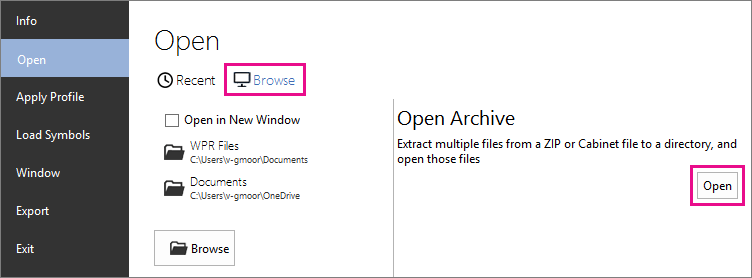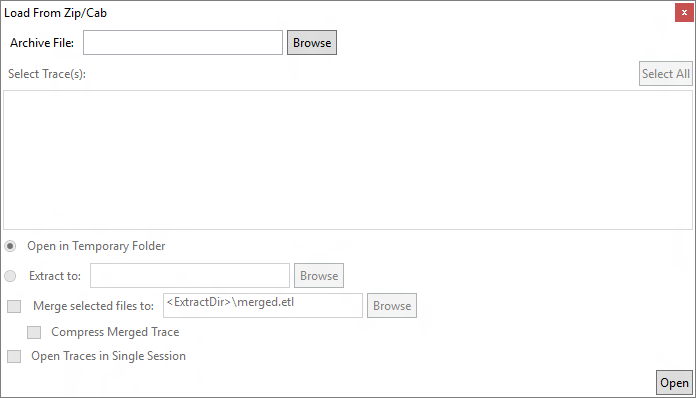Note
Access to this page requires authorization. You can try signing in or changing directories.
Access to this page requires authorization. You can try changing directories.
WPA can open ETL files that are contained in zipped files and cabinet files, two common archive formats. A dialog box in WPA, Load From Zip/Cab, enables browsing files in an archive and configuring options for extraction of ETL files from the archive.
Opening an archive
You can open Load From Zip/Cab by using File > Open to browse for a file, as for any other file that WPA can open. When you choose a zip or cab file, WPA automatically opens Load From Zip/Cab.
If you are using the rich menu, File > Open allows you to go directly to Load From Zip/Cab by clicking Open under Open Archive when Browse is selected.

Elements and options in Load From Zip/Cab
The following figure shows the Load From Zip/Cab dialog.

The elements and options of Load From Zip/Cab are described in the following table.
| Dialog element | Description |
|---|---|
| Archive File | The path and file name of the archive file. |
| Select Traces | A list of files in the selected archive file, including nested directories. |
| Extract to | The path to where you want to extract the ETL files. Specifying a location is optional. If you do not specify a path, the ETL files are extracted to a temporary folder and deleted after you close WPA. |
| Merge selected files to | Specify a path and file name to have WPA merge the extracted ETL files into a single ETL file. This is equivalent to xperf -merge. |
| Compress Merged Trace | Select this option to have WPA compress the merged file. This is equivalent to the -compress option used with xperf -merge. |
| Open Traces in Single Session | Select this option to analyze multiple traces together without merging them into a new trace. Otherwise, this option has the same limitations as merging. |
Merging traces in WPA
When extracting ETL files from an archive, you can choose to have WPA merge the traces into a single trace, which is equivalent to xperf -merge. If you do not choose to merge the traces, then all traces selected in the archive will be opened, but WPA will consider them separate traces.
As with Xperf, there are limitations to the merging of traces. In general, they must be from the same computer and captured during the same up time, without restarting.